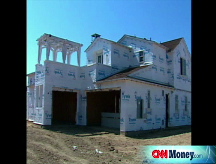Construction spending falls
Government reading for September sinks less than expected, with residential construction showing weakness.
NEW YORK (CNNMoney.com) -- Construction spending fell in September, according to a government report released Monday, although the decline was smaller than economists expected.
Spending fell 0.3%, to a seasonally adjusted annual rate of $1.06 trillion, the Commerce Department reported. That follows a 0.3% gain in August and a steep 2.4% decline in July.
The September figure is down 6.6% from the same time a year ago.
Construction spending was expected to fall by 0.8%, according to a consensus of economists surveyed by Briefing.com.
Ken Simonson, chief economist for Associated General Contractors of America, said the report shows overall weakening in construction sector, with some good news coming from nonresidential construction.
He called September's 0.1% uptick in nonresidential construction a "modest, pleasant surprise" amid reports of construction projects in the ground being frozen as financing dried up.
However, residential construction fell 1.3% from the month prior.
Both figures are down from a year ago, with residential construction spending falling 27.1% and nonresidential falling 8%.
Spending on private construction increased 0.1% in September, after sinking every month since May.
The report's strongest news came from a 1.2% increase in private nonresidential construction, but Simonson doesn't think this growth is sustainable, and expects it to drop soon. He said it doesn't make sense for developers to build new offices and stores amid news of mass layoffs and store closings.
"If there is retail construction, it's more likely they'll change the sign outside the store and make improvements inside, rather than build a new store," he said.
Private residential spending fell by 1.3%, an indication of the battered housing market.
Public construction fell 1.3%, following a 1.3% increase in August. Within the category, nonresidential spending fell the most, with the biggest cuts coming from conservation and development.
With the exception of spending in power and energy-related construction, Simonson expects other categories of spending to weaken further in October. ![]()


